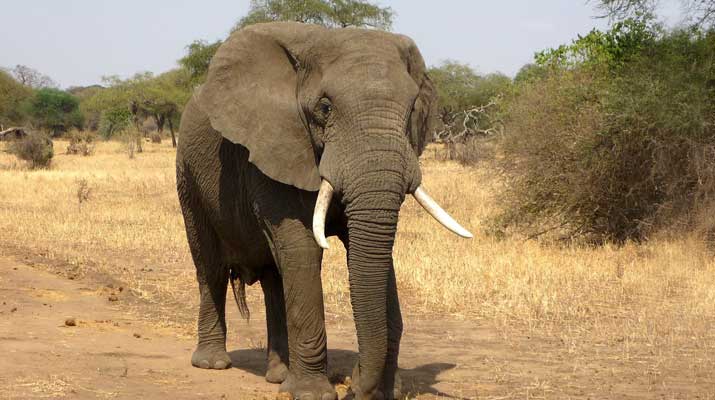
Elephants are some of the most recognizable creatures on the planet. Unmistakable large, and fascinatingly built, you can’t help but be inspired by these gentle giants.
Children are taught to admire the sheer majesty of elephants from a young age, thanks to their inclusion in cartoons and movies. Pair that with their booming presence at zoos around the world, and most people grow up with an unbreakable elephant fascination!
But what do you really know about these massive creatures?
Despite their familiarity, there’s plenty to learn about the world’s most giant land animal. Here are ten fascinating facts that will take your appreciation of elephants to a new level.
1. Elephant Species: It’s All in the Ears
There are three distinct species of elephants roaming the earth today.
For a while, zoologists believed that there were only two. However, recent studies unveiled that one type of elephant previously classified as a subspecies is an entirely different species!
We’re talking about the African Forest elephant.
They used to be lumped in with African Savannah, or Bush, elephant. Now, zoologists classify them as separate speciies
The third species is the Asian elephant.
Asian elephants roam the grasslands and forests of Southeast Asia, Sri Lanka, and India. Meanwhile, the African elephant can live across 37 countries of the continent.
The two African species have massive migration patterns. However, the African Forest elephants usually live in the Congo Basic while the African Savannah elephant resides in the arid deserts of sub-Saharan parts of the continent.
So, how can you tell these three species apart?
Beyond their distribution, look at the ears! African species have more prominent ears. Interestingly enough, they’re usually in the crude shape of the African continent.
Meanwhile, Asian elephant ears are smaller and resemble the sub-continent of India.
2. Elephant Trunks are Surprisingly Capable
Here’s another way you can tell African species apart from Asian elephants.
African elephants have two “fingers” on the end of their enormous trunks, while Asian elephants only have one. That’s not the only interesting thing about elephant trunks.
Did you know that the creature’s most iconic body part contains about 150,000 muscles?
Watch an elephant going about its day, and you’ll notice that they rely on its trunk for many things. It’s one of the most sensitive parts of their body, and its prehensile capabilities are akin to your own hands!
Elephants will use trunks to pick apart food, take out the tasty bits, and discard the rest. They’ll also use it as snorkels to breathe as they navigate high waters. Elephants can also suck up water to stay hydrated.
Fun fact: The trunk can hold about eight liters of water!
Of course, they use those trunks for sniffing, too. Many studies show that elephants have a surprisingly strong sense of smell and can detect their favorite scents.
3. The Intricacies of Elephant Communication
Everyone knows that elephants communicate verbally.
That trumpet-like sound they produce is instantly recognizable for most. But you might be surprised to learn that elephants communicate in many other ways, too.
These giants can hear sounds from great distances. Many will use subtle clicks, snorts, cries, and barks to communicate with one another. They also make low-frequency rumbling noises that humans often can’t hear.
One of the more fascinating ways of communication is through seismic signals.
Elephants can pick up on vibrations in the ground. They have enlarged ear bones and sensitive nerve endings in their feet. Those two details allow them to detect signals without making an audible peep!
Another unique tidbit: Studies show that elephants can distinguish between human language. Some even have the capability to mimic human speech patterns!
4. Elephant Memory: Truth to the Fable
One of the things people associate with elephants is their memory. But do these giants actually have a good memory? It turns out that they do!
Elephants have one of the largest brains in the animal kingdom. The part of the brain associated with memory, the temporal lobe, is bigger in an elephant than in humans.
That anatomical detail results in impeccable memory.
These animals can memorize paths to watering holes, remember directions to reliable food sources across great distances, and even remember the timing of when local fruits begin to ripen.
Elephants can also remember human faces, follow commands, and much more.
The coolest part? Elephants pass their knowledge down to younger generations. It ensures the survival of the species.
5. Modern Land Colossi
So how big are elephants anyways? They’re the largest land animal in the world. The biggest species, the African Savannah elephant, can tip the scales at about 7,500 kilograms.
They stand around three meters tall when fully grown, making them true modern mammoths.
Asian Elephants aren’t too far behind. At maturity, they can weigh as much as 6,000 kilograms and tower around 2.7 meters tall.
Males usually reach the upper end of the size spectrum, and it can take several decades to get there.
Most adults reach their full-size potential at around 35 to 40 years old. That’s about the halfway mark of the animal’s life expectancy.
But even the little ones are pretty big. Baby elephants weigh around 120 kilograms at birth and usually stand a mere 20 minutes after saying hello to the world.
6. Understanding Elephant Tusks
Elephant tusks are a rightful source of controversy. Many decades ago, poachers hunted these creatures down for their tusks made of ivory.
Thankfully, there are many laws today to protect these animals. But even still, illegal ivory trades exist.
The tusks aren’t just for show. Believe it or not, they’re teeth! Tusks are overgrown incisor teeth that begin to develop at around two years of age.
They serve a practical purpose, helping elephants dig up roots or remove bark from trees. Of course, they can also be used defensively during a fight.
Tusks continue to grow throughout the elephant’s life, so the size of these overgrown teeth is an excellent indicator of age.
The longer the tusks, the older the elephant. Both male and female African elephants develop tusks. But in Asian elephants, only the males have them.
Related: How Strong is an Elephant?
7. Elephant Eating Habits (and the Unsavory After Effects)
With their massive size, you’re probably not surprised to know that elephants eat a lot of food. But how much?
The average elephant needs about 150 kilograms of food per day! These animals need so much food that they often eat 12 to 15 hours every day.
Elephants can eat a wide variety of foods. They eat grasses, fruits, leaves, shrubs, roots, and more. When dealing with dry weather, these animals often stick to high-fiber woody foods. A good portion of the wood they eat passes unprocessed.
So, let’s talk poo! As you can imagine, all that food produces a lot of waste.
Elephants produce kilograms and kilograms of waste every day. But don’t worry: Elephant feces is good for the environment. It’s a fantastic fertilizer, and the animal’s diet of seeds and leaves often results in the spread of plants.
8. The Complexity of Elephant Emotions
One of the most beautiful characteristics of elephants is their emotional nature.
These animals are capable of many of the complex emotions you experience. They’re known to show compassion and altruism. You can even observe them helping those in need.
Elephants are sensitive creatures. With their strong memory, they form tight bonds with others in their family.
Some even grow close to humans. When those bonds are broken through separation or death, elephants will suffer.
Believe it or not, elephants can experience PTSD. Unfortunately, the signs of PTSD are common with elephants that experience trauma at the hands of poachers.
9. Elephants and Their Fascinating Social Structures
Not only are elephants emotional and compassionate, but they also have established social structures.
African elephants tend to have a more concrete hierarchy social structure. However, all elephants show familial and group bonds. African elephants live in a matriarchal society.
They respect elders and rely on them for continued survival.
As we mentioned earlier, elephants pass their knowledge on to younger generations. They share crucial information about nearby dangers, the locations of water holes and food sources, and more.
That social structure continues after death, too. Elephants exhibit many of the same behaviors as humans when an elder dies.
They mourn the loss, perform ritualistic behaviors to honor them, and frequently revisit graves to touch bones. It’s just another reason to love these gentle, sensitive giants.
10. Declining Elephants Populations: The Unsettling Truth
Prepare yourself for a darker elephant fact.
About 90 percent of the world’s elephant population was eradicated in the last century. The sudden decline is a product of the ivory trade.
Governments have primarily made the ivory trade illegal, but some operations still exist today. Sadly, the more recent efforts are considered by many to be too little too late.
There are an estimated 415,000 elephants in the world today. Asian elephants are suffering the most. Only around 45,000 exist, and they’re having trouble following their generations-old migration routes.
Currently, the Asian elephant is an endangered species. African species are considered vulnerable.
Multiple organizations are working tirelessly to protect and restore the elephant population. Still, it will be many centuries until numbers get remotely close to what they were a hundred years ago.
Conclusion
There you have it! As you can see, elephants are fascinating creatures with many unique quirks to appreciate. There’s plenty more to learn, so don’t be afraid to dive deep and read up on these giants
